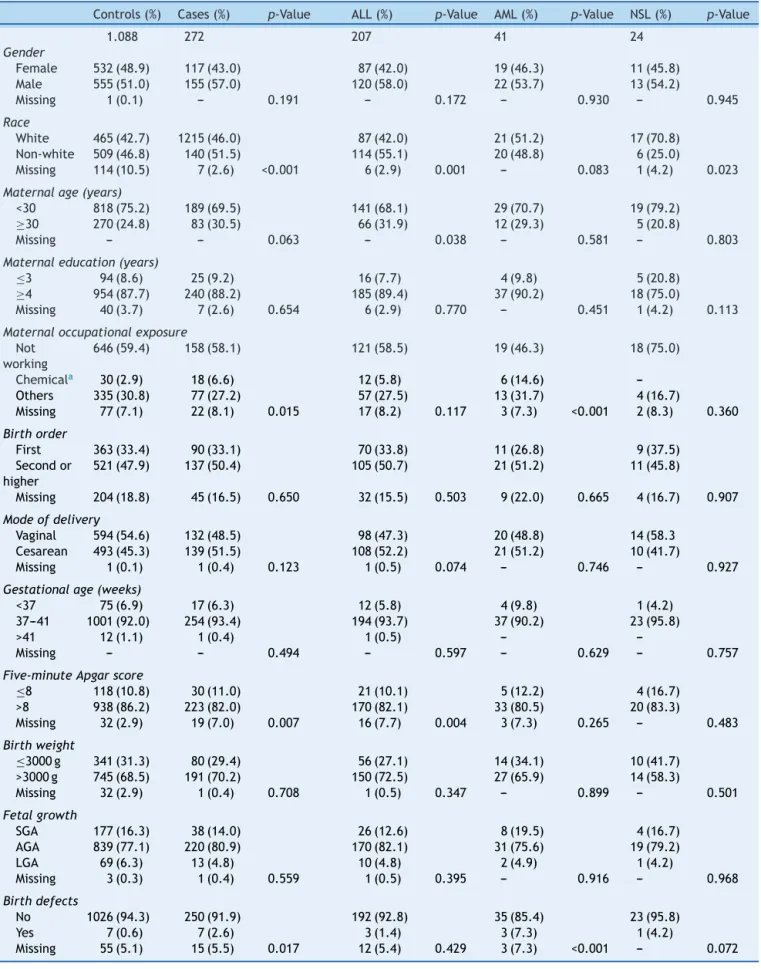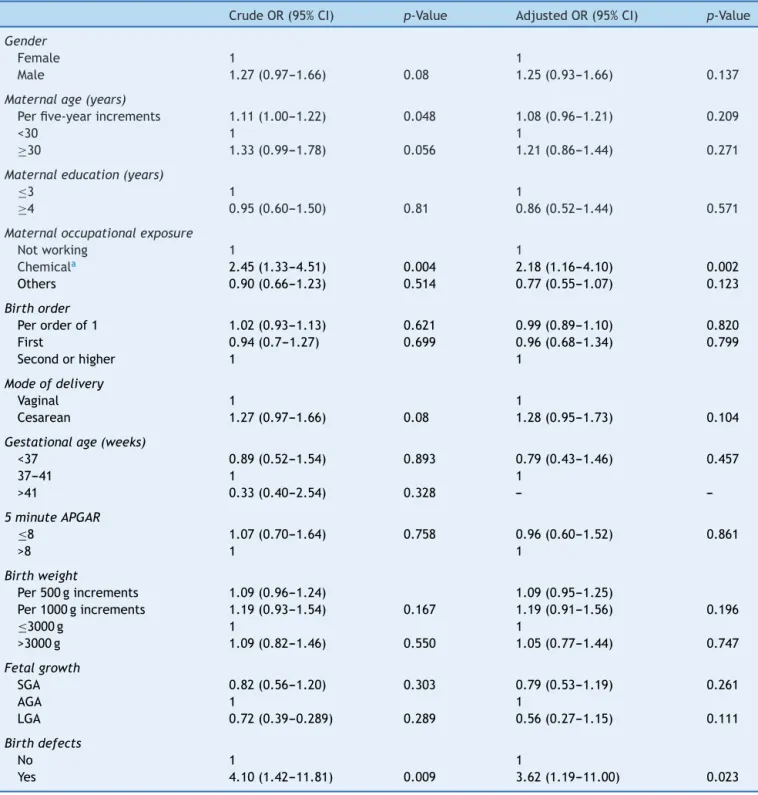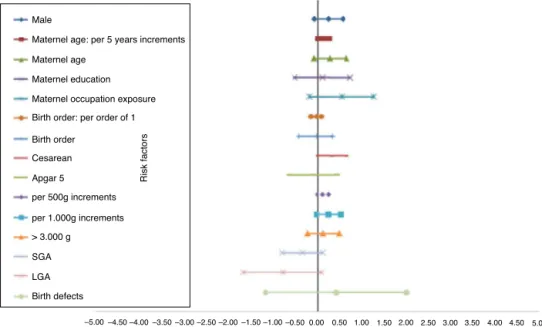www.jped.com.br
ORIGINAL
ARTICLE
Mother
and
child
characteristics
at
birth
and
early
age
leukemia:
a
case-cohort
population-based
study
夽
,
夽夽
Rejane
de
Souza
Reis
a,
Neimar
de
Paula
Silva
b,
Marceli
de
Oliveira
Santos
a,
Julio
Fernando
Pinto
Oliveira
a,
Luiz
Claudio
Santos
Thuler
c,
Beatriz
de
Camargo
b,
Maria
S.
Pombo-de-Oliveira
b,∗aInstitutoNacionaldoCâncer(INCA),Coordenac¸ãodePrevenc¸ãoeVigilância,DivisãodeVigilânciaeAnálisedeSituac¸ão,
RiodeJaneiro,RJ,Brazil
bInstitutoNacionaldoCâncer(INCA),CentrodePesquisa,ProgramadePesquisaPediátricaemHematologiaeOncologia,
RiodeJaneiro,RJ,Brazil
cInstitutoNacionaldoCâncer(INCA),CentrodePesquisa,RiodeJaneiro,RJ,Brazil
Received13September2016;accepted22December2016 Availableonline22July2017
KEYWORDS
Brazil;
Earlyageleukemia; Birthcharacteristics; Maternal
characteristics; Maternaloccupation; Birthweight
Abstract
Objective: Thepopulation-basedcancerregistries(PBCR)andtheInformationSystemonLive BirthsinBrazil(SistemadeInformac¸õessobreNascidosVivos[SINASC])haveinformationthat enablesthetestforriskfactorsassociatedwithleukemiaatanearlyage.Theaimofthisstudy wastoidentify maternalandbirthcharacteristicsassociated withearly-ageacuteleukemia (EAL)inBrazil.
Methods: Acase-cohortstudywasperformedusingsecondarydatasetinformationofPBCRand SINASC.Theriskassociationvariablesweregroupedinto(i)characteristicsofthechildatbirth and(ii)characteristicsofmaternalexposureduringpregnancy.Thecase---controlratiowas1:4. LinkagewasperformedusingRsoftware;oddsratio(OR)and95%confidenceinterval(CI)were calculatedbylogisticregressionmodels.
Results: EALwasassociatedwithmaternaloccupationalexposuretochemicals(agricultural, chemical,andpetrochemicalindustry;adjOR:2.18,95%CI:1.16---4.10)andwithbirthdefects (adjOR:3.62,95%CI:1.19---11.00).
夽
Pleasecitethisarticleas:ReisRS,SilvaNP,SantosMO,OliveiraJF,ThulerLC,deCamargoB,etal.Motherandchildcharacteristicsat
birthandearlyageleukemia:acase-cohortpopulation-basedstudy.JPediatr(RioJ).2017;93:610---8.
夽夽
StudyconductedatInstitutoNacionaldoCâncer(INCA),CentrodePesquisa,RiodeJaneiro,RJ,Brazil.
∗Correspondingauthor.
E-mail:mpombo@inca.gov.br(M.S.Pombo-de-Oliveira). http://dx.doi.org/10.1016/j.jped.2016.12.009
Conclusions: Theresultsofthisstudy,withtheidentificationofEALriskfactorsin population-based case-cohortstudy,strengthenthe knowledgeandimprove databases,contributing to investigationsonriskfactorsassociatedwithchildhoodleukemiaworldwide.
©2017SociedadeBrasileiradePediatria.PublishedbyElsevierEditoraLtda.Thisisanopen accessarticleundertheCCBY-NC-NDlicense(http://creativecommons.org/licenses/by-nc-nd/ 4.0/).
PALAVRAS-CHAVE
Brasil; Leucemiasna Infância;
Característicasao nascimento;
Exposic¸õesmaternas; Fatoresderisco; Pesoaonascer
Característicasmãe-filhoaonascereleucemiasnaprimeirainfância:umestudo
decaso-coortedebasepopulacionalnoBrasil
Resumo
Objetivos: Osregistrosdecâncerdebasepopulacional(RCBP)eoSistemaNacionaldeNascidos Vivos(SINASC)possueminformac¸õesquepossibilitamtestarhipótesessobrefatoresderiscos associadosàsleucemias.Oobjetivoprincipaldesteprojetoéidentificarquaisascaracterísticas aonascimentodascrianc¸asqueestariamassociadasaoriscodedesenvolverLeucemiaAguda (LA)naprimeirainfância.
Métodos: Foramutilizadasinformac¸õesde12RCBPedoSistemadeInformac¸ãodeNascidos Vivosdasmesmaslocalidades.Foramelegíveis272casose1.088controlesnoperíodode1996 a2010.Asassociac¸õesderiscosdeLAforamagrupadasem,(i)característicasdacrianc¸aao nascer,e(ii)característicasdeexposic¸ãomaternaduranteagestac¸ãodacrianc¸a.Arelac¸ãode casosecontrolesfoide1:4.Asanálisesparapadronizac¸ão,estruturac¸ãodobancodedadose análisesestatísticasforamrealizadasatravésdosaplicativosExcel,R-StudioeSPSS21.
Resultados: Houve associac¸ão entre anomalias congênitas (RC 3,62, IC95% 1,19-11,00) e exposic¸ãoocupacionalmaternaaprodutosquímicos(OR2,18,p0,002)comoriscodo desen-volvimentodeLA.
Conclusão: Autilizac¸ãodebancodedadossecundáriospopulacionaisparaaidentificac¸ãode fatoresderiscoparaLAfortaleceuointercâmbiodeconhecimentosemelhoriadasbasesde dados,econtribuiuparainvestigac¸õessobreasassociac¸õesderiscosnasleucemiasagudasem contextomundial.
©2017SociedadeBrasileiradePediatria.PublicadoporElsevierEditoraLtda.Este ´eumartigo OpenAccesssobumalicenc¸aCCBY-NC-ND(http://creativecommons.org/licenses/by-nc-nd/4. 0/).
Introduction
Worldwide,leukemiaisthemostcommonmalignancy diag-nosedinchildren underthe ageof5years.The incidence rate of acute lymphoblastic leukemia (ALL) has a sharp peakbetween2and4yearsofageatdiagnosis,andtends toaffectmore boysthangirls.1 The etiology ofchildhood
leukemia remains a challenge, although the premise that early-age leukemia (EAL) arises fromsomatic clonal cells originatingduringfetallifeencouragestheresearchtoward factorsassociatedwithenvironmentalexposures.1
The concept of causality has been established based onevidencesthatneedfurthertesting.Thisisparticularly true in public health and social sciences. For childhood leukemia, a causal study-model should take into con-sideration that leukemias have diverse, age-dependent, biologicalsubtypes,andaboveallamultisteppathogenesis. Someperinatalcharacteristics,suchasbirthweight,birth order, mode of delivery, maternal age, and maternal occupational exposure, have been associated with child-hood leukemia in case---control studies.2---6 Since classic
case---controlstudiescanbeinefficientin thecaseof rare diseases such as EAL, a methodological alternative is to combine a case---control study into a cohort. This study
aimed to investigate maternal and birth characteristics associatedwithEALriskfactorsusingacase-cohortmodel. Thevariableswereassessedthroughinformationgathered fromsecondarypopulation-basedregistries.
Materials
and
methods
Studydesign
Apopulation-basedcase-cohortstudywasperformed.Cases andcontrolswereobtainedfrom12population-basedcancer registries(PBCR)andfromtheInformation SystemonLive BirthsinBrazil(SistemadeInformac¸õessobreNascidosVivos [SINASC])fromthesame cities asthe PBCR.This strategy allowedallindividuals ofthepopulation base tohavethe sameprobabilityofbeingselectedtoformthecontrolgroup, regardlessofwhenthedatawascollected.
Data
Alegre,Recife,andVitória,withinformationavailable over-time(2000---2009).Theinclusioncriteriawere:childrenborn after the year 2000, aged between 0 and 5 years witha confirmeddiagnosis ofacuteleukemia (acute lymphoblas-ticleukemia[ALL],acutemyeloidleukemia[AML],andnon specifiedleukemia---[NSL])madebetween2000and2009.
Controls were selected from the SINASC, in the same citiesofthecases,whohadalsobeenbornaftertheyear 2000(n=5,623,179). Fourcontrols percase were chosen, usingsystematicrandomsamplingfromtheSINASCdataby birthorder,year,andsex.TheSINASCdatabasewasaccessed for theselection of eligiblecontrols, aswell astoobtain thepregnancyandperinatalinformationofcasesand con-trols. Multiplepregnancies were excluded fromthe study (n=104,757;1.9%).
The characteristicsat childbirthanalyzed weregender, skin color, maternal age, maternal education, maternal occupationduringthechild’spregnancy, childbirth order, mode of delivery, gestational age (weeks) at birth, five-minuteAPGARscore,birthweight,fetalgrowth,andbirth defects(ICD-10).
Maternalagewasevaluatedasacontinuousvariablewith unitsoffive-yearintervals,andacategoricalvariablewith twolevels(<30and≥30).Maternaloccupationalexposure
was classified into a categorical variable with three lev-els:(1)notworking,definedasstay-at-homemothersand students;(2) chemical,defined asworkers in the agricul-tural,chemical,andpetrochemicalindustryand,(3)others, nototherwise specified (NOS). Birth orderwascalculated from the number of previous pregnancies, counting both living and dead children plus one. The five-minute Apgar scoreswerecategorizedintotwolevels:≤8and >8.Birth
weightwasevaluated asa continuous variable withunits of 500g and 1000g, and a categorical variable with two levels(≤3000gand>3000g).Sex,birthweight,and
gesta-tionalagewereusedtoclassifyweightintogestationalage categories.Largeforgestationalage(LGA)wasdefinedas havingabirthweightabovethespecific90thpercentilefor sexandgestationalage;smallforgestationalage(SGA)was definedashavingabirthweightbelowthe10thpercentile; andappropriate for gestationalage (AGA) wasdefined as havingaweightbetweenthe10thand90thpercentiles.A large,publishedbirthcohortofbirthweightpercentilesin theBrazilian populationwasusedasareferenceforthese categories.7
Statisticalanalysis
A record linkage-based case-cohort study with PBCR and SINASCdatabases wasperformed. As these twodatabases donothaveauniqueidentifier,itwasnecessary toadopt probabilistic data linkage using the variables present in bothdatabasesandtouse differentcombinationsto com-pareandblockexclusionvariables.Thefull detailsofthis methodologyhavebeen describedelsewhere.8 TheRecord
LinkagepackagewasusedonRsoftware(RFoundationfor Statistical Computing, Viena, Austria). The probabilistic algorithm wasused to identify records related to unique individualsinbothdatabasescombined.Themother’sname wasthe key variable,and the Soundex (Brazil) algorithm (http://CRAN.R-project.org/package=soundexBR)wasused
for phonetic comparison; the Levenshtein distance was employed to compare strings. Using this record linkage methodology, 272 cases were identified, representing 73% of the EAL cases in the PBCR. One hundred cases were excluded, but there were no statistical differences regarding sex, skin color, and leukemia subtype when comparedwith272EAL.
Unconditionallogisticregressionanalysiswasperformed in SPSS (IBM Corp. Released 2012. IBM SPSS Statistics for Windows, version 21.0. NY, USA) to calculate odds ratios (OR) and 95% confidence intervals (CI) for evaluating the association between gender, maternal age, maternal edu-cation, maternal occupation during thechild’s pregnancy, birth order, gestational age (weeks), mode of delivery, five-minute Apgar score,birth weight,fetalgrowth, birth anomalies, and EAL. Separatedanalyses werecarried out forALL,AML,andNSL.Anyunivariatefindingwithap-value of<0.20wastreatedasapotentialconfounderandusedto adjustotherfindings.
Ethics
The study was approved by the Research Ethics Commit-tee of the José Alencar Gomes da Silva National Cancer Institute (Instituto Nacional do Câncer [INCA]), ref. No.: 10856213.0.0000.5274.
Results
Thefrequenciesofmaternalandperinatalvariablesamong casesandcontrols,includingsocio-demographicand gesta-tionalcharacteristics,areshowninTable1.Therewere207 cases of ALL, 41 AML, and 24 AL-NSL, and1088 controls, accordingtothedistributionof12PBCRselected.
Birth defects were predominant in AML subtypes (p=0.07). Seven cases had birth defects (Q35.9 --- cleft palate, unspecified, Q66.1--- talipes calcaneovarus, Q79.3 ---gastroschisis,Q89.9---congenitalmalformation, unspeci-fied,andQ90.9---Downsyndrome,unspecified)representing 2.6%ofEALs.Thebirthanomaliesinthecontrolgroup(0.6%) were:Q17.9---congenitalmalformationofear,unspecified, Q27.0 --- congenital absence and hypoplasia of umbilical artery,Q37.9---unspecifiedcleftpalatewithunilateralcleft lip,Q54.9---hypospadias,unspecified,Q89.8---other speci-fiedcongenitalmalformations,andQ90.9---Downsyndrome, unspecified.
The association betweenmaternal and perinatal varia-bles and EAL are shown in Table 2, through crude and adjusted analyses. There were increased and significant risk associations between EAL and chemical maternal occupationalexposures(ORcrude=2.45;95%CI:1.33---4.51);
and birth defects (ORcrude=4.10; 95% CI: 1.42---11.81).
After the adjusted analysis, maternal occupational expo-sure to chemicals and birth defects remained strongly associated with EAL (OR[adj]=2.18; 95% CI: 1.16---4.10;
OR[adj]=3.62; 95% CI: 1.19---11.00, respectively). Maternal
age was tested as a continuous variable with five-year increments(ORcrude=1.11;95%CI:1.00---1.22);cesarean(OR crude=1.28;95% CI:0.95---1.73)andbirth weightpresented
Table1 Frequencyofmaternalandperinatalcharacteristicsforcasesandcontrols,Brazil,2000---2009.
Controls(%) Cases(%) p-Value ALL(%) p-Value AML(%) p-Value NSL(%) p-Value
1.088 272 207 41 24
Gender
Female 532(48.9) 117(43.0) 87(42.0) 19(46.3) 11(45.8)
Male 555(51.0) 155(57.0) 120(58.0) 22(53.7) 13(54.2)
Missing 1(0.1) --- 0.191 --- 0.172 --- 0.930 --- 0.945
Race
White 465(42.7) 1215(46.0) 87(42.0) 21(51.2) 17(70.8)
Non-white 509(46.8) 140(51.5) 114(55.1) 20(48.8) 6(25.0)
Missing 114(10.5) 7(2.6) <0.001 6(2.9) 0.001 --- 0.083 1(4.2) 0.023
Maternalage(years)
<30 818(75.2) 189(69.5) 141(68.1) 29(70.7) 19(79.2)
≥30 270(24.8) 83(30.5) 66(31.9) 12(29.3) 5(20.8)
Missing --- --- 0.063 --- 0.038 --- 0.581 --- 0.803
Maternaleducation(years)
≤3 94(8.6) 25(9.2) 16(7.7) 4(9.8) 5(20.8)
≥4 954(87.7) 240(88.2) 185(89.4) 37(90.2) 18(75.0)
Missing 40(3.7) 7(2.6) 0.654 6(2.9) 0.770 --- 0.451 1(4.2) 0.113
Maternaloccupationalexposure
Not working
646(59.4) 158(58.1) 121(58.5) 19(46.3) 18(75.0)
Chemicala 30(2.9) 18(6.6) 12(5.8) 6(14.6)
---Others 335(30.8) 77(27.2) 57(27.5) 13(31.7) 4(16.7)
Missing 77(7.1) 22(8.1) 0.015 17(8.2) 0.117 3(7.3) <0.001 2(8.3) 0.360
Birthorder
First 363(33.4) 90(33.1) 70(33.8) 11(26.8) 9(37.5)
Secondor higher
521(47.9) 137(50.4) 105(50.7) 21(51.2) 11(45.8)
Missing 204(18.8) 45(16.5) 0.650 32(15.5) 0.503 9(22.0) 0.665 4(16.7) 0.907
Modeofdelivery
Vaginal 594(54.6) 132(48.5) 98(47.3) 20(48.8) 14(58.3
Cesarean 493(45.3) 139(51.5) 108(52.2) 21(51.2) 10(41.7)
Missing 1(0.1) 1(0.4) 0.123 1(0.5) 0.074 --- 0.746 --- 0.927
Gestationalage(weeks)
<37 75(6.9) 17(6.3) 12(5.8) 4(9.8) 1(4.2)
37---41 1001(92.0) 254(93.4) 194(93.7) 37(90.2) 23(95.8)
>41 12(1.1) 1(0.4) 1(0.5) ---
---Missing --- --- 0.494 --- 0.597 --- 0.629 --- 0.757
Five-minuteApgarscore
≤8 118(10.8) 30(11.0) 21(10.1) 5(12.2) 4(16.7)
>8 938(86.2) 223(82.0) 170(82.1) 33(80.5) 20(83.3)
Missing 32(2.9) 19(7.0) 0.007 16(7.7) 0.004 3(7.3) 0.265 --- 0.483
Birthweight
≤3000g 341(31.3) 80(29.4) 56(27.1) 14(34.1) 10(41.7)
>3000g 745(68.5) 191(70.2) 150(72.5) 27(65.9) 14(58.3)
Missing 32(2.9) 1(0.4) 0.708 1(0.5) 0.347 --- 0.899 --- 0.501
Fetalgrowth
SGA 177(16.3) 38(14.0) 26(12.6) 8(19.5) 4(16.7)
AGA 839(77.1) 220(80.9) 170(82.1) 31(75.6) 19(79.2)
LGA 69(6.3) 13(4.8) 10(4.8) 2(4.9) 1(4.2)
Missing 3(0.3) 1(0.4) 0.559 1(0.5) 0.395 --- 0.916 --- 0.968
Birthdefects
No 1026(94.3) 250(91.9) 192(92.8) 35(85.4) 23(95.8)
Yes 7(0.6) 7(2.6) 3(1.4) 3(7.3) 1(4.2)
Missing 55(5.1) 15(5.5) 0.017 12(5.4) 0.429 3(7.3) <0.001 --- 0.072
ALL,acutelymphoblasticleukemia;AML,acutemyeloidleukemia;NSL,non-specifiedleukemia;SGA,smallforgestationalage;AGA,
appropriateforgestationalage;LGA,largeforgestationalage.
Table2 Associationbetweenmaternalandperinatalcharacteristicsandearly-ageacuteleukemia,Brazil,2000---2009.
CrudeOR(95%CI) p-Value AdjustedOR(95%CI) p-Value
Gender
Female 1 1
Male 1.27(0.97---1.66) 0.08 1.25(0.93---1.66) 0.137
Maternalage(years)
Perfive-yearincrements 1.11(1.00---1.22) 0.048 1.08(0.96---1.21) 0.209
<30 1 1
≥30 1.33(0.99---1.78) 0.056 1.21(0.86---1.44) 0.271
Maternaleducation(years)
≤3 1 1
≥4 0.95(0.60---1.50) 0.81 0.86(0.52---1.44) 0.571
Maternaloccupationalexposure
Notworking 1 1
Chemicala 2.45(1.33---4.51) 0.004 2.18(1.16---4.10) 0.002
Others 0.90(0.66---1.23) 0.514 0.77(0.55---1.07) 0.123
Birthorder
Perorderof1 1.02(0.93---1.13) 0.621 0.99(0.89---1.10) 0.820
First 0.94(0.7---1.27) 0.699 0.96(0.68---1.34) 0.799
Secondorhigher 1 1
Modeofdelivery
Vaginal 1 1
Cesarean 1.27(0.97---1.66) 0.08 1.28(0.95---1.73) 0.104
Gestationalage(weeks)
<37 0.89(0.52---1.54) 0.893 0.79(0.43---1.46) 0.457
37---41 1 1
>41 0.33(0.40---2.54) 0.328 ---
---5minuteAPGAR
≤8 1.07(0.70---1.64) 0.758 0.96(0.60---1.52) 0.861
>8 1 1
Birthweight
Per500gincrements 1.09(0.96---1.24) 1.09(0.95---1.25)
Per1000gincrements 1.19(0.93---1.54) 0.167 1.19(0.91---1.56) 0.196
≤3000g 1 1
>3000g 1.09(0.82---1.46) 0.550 1.05(0.77---1.44) 0.747
Fetalgrowth
SGA 0.82(0.56---1.20) 0.303 0.79(0.53---1.19) 0.261
AGA 1 1
LGA 0.72(0.39---0.289) 0.289 0.56(0.27---1.15) 0.111
Birthdefects
No 1 1
Yes 4.10(1.42---11.81) 0.009 3.62(1.19---11.00) 0.023
OR,oddsratio;CI,confidenceinterval;SGA,smallforgestationalage;AGA,appropriateforgestationalage;LGA,largeforgestational
age.
aWorkersintheagricultural,chemical,andpetrochemicalindustry.
cases(>41gestationweeks)variablefromthefit analysis, whentheadjORwascalculated.
The distinct magnitude of risk associations between maternal and perinatal characteristics and ALL are describedinFig.1,whereasFig.2showstheriskassociations withAML.Independent, marginallysignificant,riskfactors for ALL were: gender (OR[adj]=1.29; 95% CI: 0.93---1.78);
continuous maternal age (per five-year increments; OR[adj]=1.78; 95%CI: 1.00---1.30);maternal age≥30 years
(OR[adj]=1.33; 95% CI: 0.92---1.93); delivery by cesarean
section (OR[adj]=1.35; 95% CI: 0.97---1.89); continuous
birth weight(per 500g; OR[adj]=1.13;95% CI: 0.99---1.29);
and continuous birth weight (per 1000g; OR[adj]=1.28;
Male
Maternel age: per 5 years increments
Maternel age
Maternel education
Maternel occupation exposure
Birth order: per order of 1
Birth order
Cesarean
Apgar 5
per 500g increments
Risk factors
per 1.000g increments
> 3.000 g
SGA
LGA
Birth defects
–5.00 –4.50–4.00–3.50–3.00–2.50–2.00–1.50–1.00 –0.500.00 Log OR
0.50 1.00 1.50 2.00 2.50 3.00 3.50 4.00 4.50 5.00
Figure1 Adjustedriskestimatesformaternalandperinatalcharacteristicsandacutelymphoblasticleukemia,Brazil2000---2009. OR,oddsratio;SGA,smallforgestationalage;LGA,largeforgestationalage.
factors were associated: chemical maternal occupational exposure (OR [adj]=8.24; 95% CI: 2.91---23.39) and the
presence of birth defects (OR[adj]=16.39; 95% CI:
3.86---69.55).
Discussion
Childhood leukemia is the most common pediatric malig-nancy,andthepeakincidenceisbetween2and5yearsof ageinmostpopulations,suggestinginuterodevelopment.
Maternalandperinatalcharacteristicsaredescribedas pos-sibleriskfactors.1 Arecordlinkage case-cohortstudy was
conducted in which data collected from two population-based studies were explored. One of the datasets used, the SINASC, wascreated in 1990; since the year 2000, it hasbeen recognizedasagoodqualitybirth registry, with accurateinformation.9Similarly,theBrazilianPBCRusedin
this study has been consider by the International Agency for Research on Cancer (IARC) to be of good quality; it wasclassifiedasagroupBdefinedcoverage(approximately
Male
Maternal age: per 5 years increments
Maternal age
Maternal education
Maternal occupational exposure
Birth order: per order of 1
Birth order
Cesarean
Apgar 5
per 500g increments
per 1.000g increments
>3.000 g
SGA
LGA
Birth defects
–5.00 –4.50–4.00–3.50–3.00–2.50–2.00–1.50–1.00 –0.500.00
Log OR
0.50 1.00 1.50 2.00 2.50 3.003.504.00 4.50 5.00
Risk factors
50%) with the parameters suggested for incidence rate analysis.10Therefore,thepresentstudy,withrecordlinkage
population-based case-cohort approach, provided reliable results concerning the risk factors associated with EAL in Brazil. Perinatal, maternal occupation, and mother-child characteristics in relation to EAL were explored herein.
Some studies have shown increased risk of childhood leukemiaassociatedwithmaternaloccupationalexposures duringpregnancy,especiallyforwomenworkinginthefront line of agricultural activities or exposed to pesticides or solvents.11,12Inthispopulation-basedcase-cohortstudy,an
increasedassociated riskrate wasobserved among moth-ersself-identifiedasworkersintheagricultural,chemical, andpetrochemicalindustries;aneight-foldriskofAMLwas observed. These results corroborate those of a previous hospital-based case---control study, which found a strong association of maternal exposure to pesticides andinfant leukemiainBrazil.12
Conceptionatadvancedmaternalagehasbeendescribed asachildhoodleukemiariskfactor,althoughwithan incon-sistentresultinsomestudies.13,14Inthepresentanalysis,a
statisticallymarginallysignificantassociationwithEALwas foundwithmaternalageevaluatedascontinuousvariable. However,asignificantriskwasobservedforALL(OR=1.7).A possibleexplanationfortheassociationofadvanced mater-nalageandALLcouldbethegametes’long-termexposure toenvironmentalagents.15Deliverybycesareansectionwas
alsoassociatedwithALL(HR=1.35). Deliveryby cesarean section had been previously found to be associated with ALL in Hispanics in an international pooled analysis of case---controlstudies.16 Alongwiththisepidemiological
evi-dence,maternaleducationwasalsofoundtobeassociated withincreasedriskforALLdevelopmentwhenmothershad aneducationlevelhigherthanhighschool(HR=1.21;95%CI: 1.0---1.47)indevelopedcountries.17Arecentstudyanalyzed
ALLandmaternaleducationinnEgyptianchildren,observing anassociationbetweenhigheducationallevelandALLrisk (OR=2.05;95%CI:1.46---2.88).18 Usingmaternal education
asaproxyvariableforsocioeconomicindicatorlevel(SES-i), noassociation wasobservedbetweenEALandSES-iinthe entireBrazilianPBCRsettings.However,basedthis informa-tion,givenasanimplicitcomparison,theresultsobserved inthisstudymustbeanalyzedprudentlyforthe aforemen-tionedreasons. The SES-i basedonmaternal educationis not perfect; however, the SINASC dataset has good com-pleteness andstrong positive association of lower mater-nal education with poor SES-i (http://www.ibge.gov.br). Maternaleducationincasesandcontrolsmightreflectthe social environment experience by all participants in this analysis.
Othervariables,suchasgestationalage,Apgarscoreat birth,birthorder,andbirthweightwerenotassociatedwith EAL.Childrenwithlow five-minute Apgar score hadsome unfavorableresultsofdelivery,andthisscoreisapredictor ofchildhoodcancer,mainlysolidtumors,butnotchildhood leukemia.19---22
Among all birth characteristics, birth weight has been well-described asa risk factor for ALL in early ages and for some pediatric embryonal tumors.2---5 Although birth
weightwasnotassociatedwithEALinthepresent investi-gation,inapreviousBraziliancase---controldesignedstudy,
the odds ratio between i-ALL and birth weightwas 1.30, afteradjustingforconfounderssuchassex, maternalage, family income, and pesticide exposure during pregnancy. In that study, the hospital-based controls were in the stratum of 4000g or more, comparatively to those born weigh in between 2500 and 2999g.23 To understand the
potentialbiological mechanismsthatmayexplain thelink betweenhighbirthweightandriskofALL,itisimportantto differentiatehighabsoluteweightandhighrelativeweight atbirth.Birthweightadjustedforgestationalagewasfirst examinedfortheriskofALLintwoEnglishdatabases,and no significant associations were observed (absolute birth weightandweightadjustedforgestationalage).24Recently,
the Childhood Leukemia International Consortium (CLIC), using a pooled analysis of case---control studies, demon-strated that accelerated fetal growth is associated with anincreasedriskofALL.4This evidenceraisesspeculation
aboutthefunctionofinsulin-likereceptorgenefamily, espe-ciallytheinsulin-likegrowthfactor-1 (IGF-1).The ratioof IGF-Iconcentration measured in umbilical cordblood and positively associatedwith birth weight,placental weight, andweightindexwereassessed;high circulatinglevelsof IGF-Iwerereportedininfantswithhighbirthweight.25,26
Birthdefectsareastrongassociatedriskfactorfor child-hood cancer. Down syndrome is a well-known risk factor for infantleukemia,especiallyforAML.27,28 Inthepresent
study,ahighriskforAML(threebirthanomaliesamong41 cases)wasobserved.ThethreebirthanomalieswereDown syndrome,cleftpalate,andunspecifiedcongenital malfor-mation(oneeach).
Some considerations should be mentioned regarding the limitations of the present results. Firstly, the loss of 27% of cases not found when linking the two databases (PBCR/SINASC) may have compromised the interpretation of results,although theeffectwouldbe lossof statistical power,butnochangeintherisk.Ithasbeendescribedthat 35%ofBraziliansdonotliveinthecityofbirth.9,29Themost
likely explanation for the loss of matched cases---controls isthatmigrationisverycommoninBrazil,mainlybecause parentslookforopportunitiesinlargecities,consequently with loss of outcomes in city of birth. Another limita-tionregardedspecificmaternaloccupationalexposuredata, whose completeness in SINASC is considered low. The definitionofcategoriesinSINASCandPBCRconcerning occu-pation followstheupdatedresolution ofthe International Standard Classification of Occupations (ISCO-08). Occupa-tion is defined as a set of activities characterized by a highdegreeofsimilarityinISCO-8,althoughnotrelatedto specificexposures.11 Becauseofthesmallnumberineach
category assessment,the variablesagricultural,chemical, and petrochemical industries were combined in a single group asoccupational exposurestopotentialcarcinogenic substances.Acausalstudymodelshouldtakeintoaccount thediversecellsubtypesofchildhoodleukemia,andthelow completenessofthesevariablesinPBCRrepresentsanother limitationofthisanalysis.
lack of definition has not led to differential error direc-tioninthe presentresults ofabsoluterisk factorsfor EAL inBrazil.
The strengthsof this study shouldbe alsohighlighted. Firstly, the case-cohort design assumes that all variables wereobtainedatthebeginningofthestudy(atbase-line), thus,datawereobtainedbeforeanydiseasedeveloped. Sec-ondly,datafromtwogoodqualitypopulation-baseddatasets wereused,whichincreasesthelikelihoodthatthesefindings representactualriskfactors.Despitealltheaforementioned limitations, this was the first study in Brazil to consult twosecondary databasesin ordertoestablish an associa-tionbetweenriskfactorsandthedevelopmentofleukemia in children at an early age. Finally, the authors believe that the present findings provides evidence that mater-nal exposures during pregnancy and birth characteristics shouldbestudiedingreaterdepthascause-effectinutero leukemogenesis.
Conflicts
of
interest
Theauthorsdeclarenoconflictsofinterest.
Acknowledgements
The authors are grateful to all the coordinators of the PBCRs and the SINASC in Brazil who contributed to this work, including those in Aracaju/SE, Belém/PA, BeloHorizonte/MG,Cuiabá/MT,Curitiba/PR,Fortaleza/CE, João Pessoa/PB, Manaus/AM, Natal/RN, Porto Alegre/RS, Recife/PE,andVitória/ES.
References
1.Greaves MF. Aetiology of acute leukaemia. Lancet. 1997;349:344---9.
2.CaugheyRW,MichelsKB.Birthweightachildhoodleukemia:a meta-analysisandreviewofthecurrentevidence.IntJCancer. 2009;124:2658---70.
3.Oksuzyan S, Crespi CM, Cockburn M, Mezei G, Kheifets L. Birth weight and other perinatal characteristics and child-hood leukemia in California. Cancer Epidemiol. 2012;36: e359---65.
4.Milne E, Greenop KR, Metayer C, Schüz J, Petridou E, Pombo-de-Oliveira MS, et al. Fetal growth and childhood acute lymphoblastic leukemia: findings from the childhood leukemia international consortium. Int J Cancer. 2013;133: 2968---79.
5.LiJ,CnattingusS,GisslerM,VestergaardM,ObelC,Ahrensberg J,etal.The5-minuteAPGARscoreasapredictorofchildhood cancer:apopulation-basedcohortstudyinfivemillionchildren. BMJOpen.2012;2:e001095.
6.Marcotte EL, Thomopoulos TP, Infante-Rivard C, Clavel J, Petridou E, Schüz J, et al. Caesarean delivery and risk of childhood leukaemia: a pooled analysis from the Childhood LeukemiaInternational Consortium(CLIC).Lancet Haematol. 2016;3:e176---85.
7.Pedreira CE, Pinto FA, Pereira SP, Costa ES. Birth weight patterns by gestational age in Brazil. An Acad Bras Cienc. 2011;83:619---25.
8.dePaulaNS,ReisRS,CunhaRG,OliveiraJF,LimaFC, Pombo-de-OliveiraMS,etal.Birthweightandriskofchildhoodsolid
tumorsin Brazil:arecordlinkage between population-based datasets.RevPanamSaludPublica.2017;41:e14.
9.FriasPG,SzwarcwaldCL,LiraPI.Evaluationofinformation sys-temsonlivebirthsandmortalityinBrazilinthe2000.CadSaude Publica.2014;30:2068---80.
10.FerlayJ,SoerjomataramI,DikshitR,EserS,MathersC,Rebelo M,etal.Cancerincidenceandmortalityworldwide:sources, methodsandmajorpatternsinGLOBOCAN2012.IntJCancer. 2014;136:359---86.
11.Infante-RivardC, Siemiatycki J, LakhaniR, NadonL. Mater-nalexposuretooccupationalsolventsandchildhoodleukemia. EnvironHealthPerspect.2005;113:787---92.
12.Ferreira JD, Couto AC, Pombo-de-Oliveira MS, Koifman S, BrazilianCollaborativeStudyGroupofInfantAcuteLeukemia. In utero pesticide exposure and leukemia in Brazilian chil-dren<2 years of age. Environ Health Perspect. 2013;121: 269---75.
13.Podvin D, Kuehn CM, Mueller BA, Williams M. Maternal and birthcharacteristicsinrelationto childhoodleukaemia. Pae-diatrPerinatEpidemiol.2006;20:312---22.
14.Spector LG, Davies SM, Robison LL, Hilden JM, Roesler M, RossJA.Birth characteristics,maternal reproductivehistory, and theriskofinfantleukemia:areportfromthechildren’s oncology group.Cancer EpidemiolBiomarkers Prev. 2007;16: 128---34.
15.Infante-RivardC,SinnettD.Preconceptionalpaternalexposure topesticidesandincreasedriskofchildhoodleukaemia.Lancet. 1999;354:1819.
16.FrancisSS,SelvinS,MetayerC,WallaceAD,CrouseV,MooreTB, etal.Modeofdeliveryandriskofchildhoodleukemia.Cancer EpidemiolBiomarkersPrev.2014;23:876---81.
17.JohnsonKJ,SolerJT,PuumalaSE,RossJA,SpectorLG.Parental andinfantcharacteristicsandchildhoodleukemiainMinnesota. BMCPediatr.2008;8:e1---10.
18.EzzatS,RashedWM,SalemS,DorakMT,El-DalyM,Abdel-Hamid M,etal.Environmental,maternal,andreproductiverisk fac-torsfor childhoodacute lymphoblastic leukemiain Egypt: a case---controlstudy.BMCCancer.2016;16:662.
19.LiJ,CnattingusS,GisslerM,VestergaardM,ObelC,Ahrensberg J,etal.The5-minuteAPGARscoreasapredictorofchildhood cancer:apopulation-basedcohortstudyinfivemillionchildren. BMJOpen.2012;2,pii:e001095.
20.WestergaardT,AndersenPK,PedersenJB,OlsenJH,FrischM, SorensenHT,etal.Birthcharacteristics,siblingpatterns,and acute leukemiarisk inchildhood: a population-based cohort study.JNatlCancerInst.1997;89:939---47.
21.HjalgrimLL,WestergaardT,RostgaardK,SchmiegelowK, Mel-bye M, Hjalgrim H, et al. Birth weight as a risk factor for childhoodleukemia:ameta-analysisof18epidemiologic stud-ies.AmJEpidemiol.2003;158:724---35.
22.Barahmani N, Dorak MT, Forman MR, Sprehe MR, Scheurer ME,Bondy ML,et al.Evaluatingtheroleofbirthweightand gestational ageon acutelymphoblastic leukemiarisk among those ofhispanicethnicity.Pediatr HematolOncol. 2015;32: 382---9.
23.KoifmanS,Pombo-de-OliveiraMS.TheBrazilianCollaborative StudyGroup ofInfant AcuteLeukemia.Highbirthweight as an important risk factor for infant leukemia. Br J Cancer. 2008;98:664---7.
24.GlinianaiaSV, PearceMS,RankinJ,Pless-Mulloli T,Parker L, McNallyRJ.Birthweightbygestationalageandriskof child-hood acute leukemia: a population-based study 1961---2002. LeukLymphoma.2011;52:709---12.
26.MurphyVE,SmithR,GilesWB,CliftonVL.Endocrineregulation ofhumanfetalgrowth:theroleofthemother,placenta,and fetus.EndocrRev.2006;27:141---69.
27.Bruwier A, Chantrain CF. Hematological disorders and leukemia in children with Down syndrome. Eur J Pediatr. 2012;171:1301---7.
28.BottoLD,FloodT,LittleJ,FluchelMN,KrikovS,FeldkampML, etal.Cancerriskinchildrenandadolescentswithbirthdefects: apopulation-basedcohortstudy.PLOSONE.2013;8:e69077.


